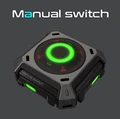
A sample of Interactive Elements; the player can be seen standing on a sensor, which is triggering the two lights it is connected to.
Interactive Elements are Elements which are able to be linked with their surroundings to perform simple actions without the need for programming. The system is a simple input-output system; a sensor or switch can be hooked up to a light or a door to allow for events to occur when something triggers the sensor or switch.
Inputs
Pressure Plate
- The pressure plate is a sensor which can detect when a player is standing on it. When triggered, it switches between its 2 states (activated or deactivated) and emits the corresponding event.
Laser Sensor (Emitter and Receiver)
- The laser sensor is able to detect players (or objects) at extended range. The laser extends from the emitter towards the receiver; if it hits a player (or an object), the sensor is triggered.
Manual Button
- The manual button is a small element which can be activated by hand. By default it is in a "released" state, but when activated it become in a "pressed" state during a short time and emits the corresponding events. If connected to a Programming Board, it provides the events "pressed()" and "released()", and the function "getState()".
Manual Switch
- The manual switch is a small element which can be activated by hand. When activated, it switches between its 2 states (pressed or released) and emits the corresponding event. If connected to a Programming Board, it provides the events "pressed()" and "released()", and the function "getState()".
Pulser
- The pulser unit is a small element which is capable of pulsing a signal. It switches between its 2 states at a certain frequency and triggers the corresponding events. It is unknown at this time if the frequency of the pulser can be configured.
Light Detector
- The light detector is a sensor which can react to the level of light it is exposed to. There is no information yet about how it is working.
Outputs
Lamp
- The lamp is a light source which has 2 states: on and off. A lamp will keep its current state until it receives an opposit instruction..
Force Field
- The force field is a solid wall which has 2 states: activated and deactivated. It allows the instantaneous creation and removal of solid walls anywhere that voxels are not present. A force field will keep its current state until it receives an opposit instruction.
Door
- A door has 2 states, it can be opened or closed. A door will keep its current state until it receives an opposit instruction. If connected to a Programming Board, it provides the functions "activate()" which open the door and "deactivate()" which (probably) close the door.
Logic Gates
- In addition to inputs and outputs, there are logic gates. While inputs reside at the beginning of systems and outputs reside at the end, logic gates have their place in the middle of systems where they perform operations based on the state of their inputs. There are currently three logic gates in Dual Universe.
AND gate

- The AND gate accepts any number of inputs, but will only send an active signal if all of its inputs are active. If an AND gate has three sensors hooked up to it and is connected to a light, the light will only turn on if all three sensors are activated.
OR gate
- An OR gate can have any number of inputs, and will send and active signal if any of them are activated. If three sensors are hooked up to an OR gate, and the gate is connected to a light, triggering one or more sensors will turn on the light.
NOT gate
- A NOT gate can have only one input. A NOT gate reverses the state of that input; if a sensor is hooked up to a NOT gate, and the sensor is not being triggered, than the NOT gate will be sending an active signal. As soon as the sensor is triggered, then the NOT gate's signal will deactivate.









